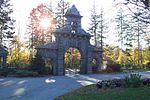Wamesit Canal-Whipple Mill Industrial Complex
Ammunition manufacturersBuildings and structures in Lowell, MassachusettsExplosives manufacturersGunpowder millsHistoric districts in Middlesex County, Massachusetts ... and 5 more
Historic districts on the National Register of Historic Places in MassachusettsMiddlesex County, Massachusetts Registered Historic Place stubsNRHP infobox with nocatNational Register of Historic Places in Lowell, MassachusettsUse mdy dates from August 2023

The Wamesit Canal-Whipple Mill Industrial Complex is a historic mill and canal at 576 Lawrence Street in Lowell, Massachusetts. This industrial area of Lowell, located on the Concord River, underwent a major expansion from a more modest millworks in the mid-19th century by Oliver Whipple, a manufacturer of gunpowder.
Excerpt from the Wikipedia article Wamesit Canal-Whipple Mill Industrial Complex (License: CC BY-SA 3.0, Authors, Images).Wamesit Canal-Whipple Mill Industrial Complex
Faulkner Street, Lowell
Geographical coordinates (GPS) Address Nearby Places Show on map
Geographical coordinates (GPS)
| Latitude | Longitude |
|---|---|
| N 42.6325 ° | E -71.300833333333 ° |
Address
Faulkner Street 14
01825 Lowell
Massachusetts, United States
Open on Google Maps











